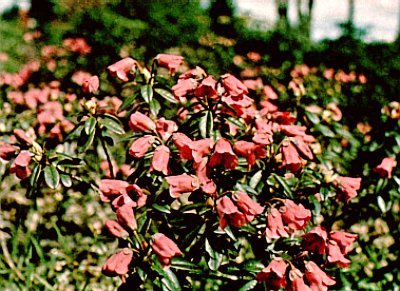R. campylogynum var. cremastum
Harold Greer, Eugene, Oregon

|
|
R. campylogynum
var.
cremasturn
Photo by Harold Greer |
Little thimble shaped flowers nodding gracefully in a field of exquisite green foliage would describe
R. campylogynum
var.
cremastum
. What a joy this plant is to have in the garden. It is a species that is good all year. In the winter the foliage is bronzy red making a nice contrast with the other greens and the textures produced by the deciduous plants. In spring it produces a very heavy crop of waxy flowers of heavy substance. There is some variation in color between various forms of
R. campylogynum
var.
cremastum
, but most are rosy salmon with a slight purplish cast. A very enchanting flower color. There is a red form which was known as
R. amphichlorum
, but which is properly known as
R. campylogynum
var.
cremastum
.
Few other rhododendrons can be confused with
R. campylogynum
. It is the single member of the Campylogynum Series and could be placed nearest to the Glaucophyllum Series. It also has some similarities to the Uniflorum and Lepidotum Series. The shape of the flowers and the bent ovary (campylogynum means bent ovary) make it distinct from other species.
There are four distinct varieties of
R. campylogynum
var.
charopoeum
which has the largest flowers;
celsum
which is the tallest growing;
myrtilloides
which is the smallest and most dwarf; and
cremastum
which is medium sized with leaves that are pale green on both the upper and lower surfaces. Most of the other varieties are white glaucous beneath the leaves.
R. campylogynum
was first discovered by Delavay in 1884 in western Yunnan. It was later found in Tibet and Burma and was introduced by Forrest in 1912. It grows in the wild at altitudes of between 9,000 and 15,000 feet on open rock hillsides, mossy boulders, and clefts of granite cliffs.
The form pictured is of unknown origin, but is an extremely fine little form which is very free flowering. We have grown it in the garden for many years and have always appreciated the show it makes. We have found it an easy species to grow. It propagates easily and rapidly, becomes a stout little plant which buds young. It has a H2 hardiness rating, but I would say that it is hardy to about -10° F. It grows to two feet tall and flowers at about early mid-season after many of the dwarfs have passed their peak. For quality rating it is given a 4/3. Actually it probably deserves a plant rating of 4 except for the fact that as an older plant in a shady location it will sometimes become a bit open and leggy. There is however a good thing about this as the bark exfoliates and is attractive.
All around this is a plant that is charming.